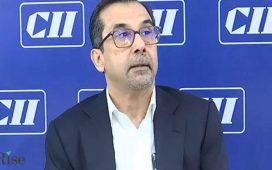Mayur Sundararajan (MS): In 2022, the Indian ceiling fan market size reached 41.2 million units. IMARC Group expects it to grow at 2.3% (CAGR) between 2023 and 2028 and reach 47.5 million units by 2028. Historically, dominant large appliance brands like Crompton, Orient, Havells, Usha, and Bajaj have commanded about 60% of this market.
This landscape changed when we launched the country’s first super energy-efficient fan on December 12, 2012. A decade after that initial impetus, the industry is undergoing a seismic shift, catalysed by new entrants and the mandatory Bureau of Energy Efficiency (BEE) star labelling enforced on ceiling fans on January 1, 2023. With these regulations, the old 75-80W AC induction motor fans, which once held a 95% market share, became obsolete overnight, unable to meet the new 1-star rating efficiency criteria set at a maximum of 55W for comparable airflow.
Energy Efficiency Services Limited, a JV of government entities, also plans to distribute 1 crore super energy efficient fans. Though this program has several challenges that plagued the earlier failed programs, it would raise some awareness to increase the market penetration.
This radical regulation change and growing general awareness over energy savings has spurred an upsurge in consumer awareness and demand for super energy efficient fans, which are BEE 5-star rated fans. This segment is catered to by only BLDC motor-based fans, courtesy of early market alignment and supply chain adaptation since our launch. These BLDC motor-based fans typically consume 32-35W while delivering the market-required airflow, and there are some fans even at 25W, so there are savings of well over 50% in electricity.ET: What are the product innovations taking place in the industry and what are the current trends? What do consumers want?
MS: The past decade has witnessed the fan industry pivot towards super energy efficiency, with BLDC motor technology at the forefront. This BLDC motor technology has various design approaches that are being explored by manufacturers, many of whom rely on external motor solution providers and semiconductor manufacturers. The key goal for the industry is cost reduction, aiming to make energy-efficient fans as affordable as their AC induction counterparts.

The design of a BLDC motor.
Consumers seek not just affordability but also thermal comfort, which is a fan’s primary function. The evolution of control interfaces from traditional regulators to remote controls, and now advancing to integration with smart-home systems like Alexa and Google Home, reflects the rising trend of interconnected home environments. As there is a trend towards elaborate interior design, we offer fans in various colours and finishes, including wood and metallic, to integrate with modern decor seamlessly.
Policy frameworks like the India Cooling Action Plan (ICAP) are also shaping market trends by emphasising human thermal comfort, which will likely influence fan manufacturers’ technology, supply chain, and marketing strategies.
Anticipated regulatory expansions to encompass other fan types – table fans, wall fans, pedestal fans, exhaust fans, etc.- will further move the industry towards energy-saving solutions.
Thus, innovation is not just in product design but extends to manufacturing efficiencies, supply chain optimisation, noise reduction, and aesthetic enhancements, all while keeping a keen eye on cost-effectiveness.
ET: The fan market has a number of players, both big and small. According to you, how can a company scale and what are the ingredients to succeed? Is India a very price sensitive market?
MS: Superfan has been proving in the last decade that the market is receptive to technologically advanced, reliable products. At the same time, Atomberg has demonstrated in the previous 5-years that substantial investment in marketing is required to capture the market traditionally and showed that the fan industry could draw large capital. However, their strategy to pursue market share at the expense of significant losses has shown its limits. Therefore, the path to sustainable scaling lies beyond just innovation in core product technology, like BLDC motor tech. It requires innovation across various business facets, including sales, marketing, after-sales service, and logistics, to create a robust growth model for the industry.
As the industry is in flux, popular brands from other industries are venturing into the fans segment, so in the next few years, there may be more competition.
Price sensitivity exists across all consumer durables in India, yet there is a trend of increasing costs over time, influenced by technology, imports, and stringent regulations. This is clear in the last decade’s rise in the prices of TVs, refrigerators, air conditioners, geysers, and kitchen appliances. The fan industry is similarly positioned, with regulatory changes and technological innovations leading to enhanced features and improved performance and value. Consequently, the intrinsic value of fans will increase, justifying the rise in prices. In the last 2 years, there has been at least a 6% price uptick partly because of the regulatory change and the impact of the pandemic, which is a signal of an increase in fan pricing.
ET: With climate change becoming a major factor and the world heating, what are the threats and opportunities for the industry and your company? Do you think increasing use of air conditioners may impede growth?
MB: According to The Center for Science and Environment (a New Delhi-based public interest research and advocacy organisation), through 314 days out of 365 days, India has experienced extreme weather events on the whole. At least one extreme weather event was reported in some parts of India daily, and one of the main ones was the heat waves. There have been fatalities in hundreds due to heat waves in the northern region, where temperatures soared to around 46 degrees Celsius. This highlights the urgent need for efficient thermal comfort solutions, as thermal comfort is becoming necessary.

Superfan says for the segment to develop, it requires innovation across various business facets, including sales, marketing, after-sales service, and logistics, In pic – a Superfan warehouse.
Fans leverage the natural human cooling mechanism—evaporative cooling of sweat — to themselves. It is both energy efficient and environmentally friendly compared to the conductive cooling mechanism of cooling the occupant by air conditioners.
Moreover, air conditioners create a microclimate effect called the ‘urban heat island effect’ — where expelled heat from ACs heats high-density areas like cities, resulting in an increased need for ACs, creating a vicious loop. Combining fans and ACs can minimise the effect, especially BLDC fans are more apt as the motor does not heat up like an AC induction motor.
This hybrid method can be practiced by setting the air conditioner to 27-28 degrees Celsius and using a Superfan-like BLDC fan at low-medium settings, and the occupant can achieve the equivalent comfort of 24-degree Celsius temperature setting while reducing energy consumption by approximately 25% and minimising the heat island effect as the thermal load of the AC is lower. This integrative strategy is pertinent for the growing population and also for global sustainability efforts. Thus, climate change is an opportunity for the industry rather than a direct challenge.
ET: Certain regions like Europe are increasingly looking at cooling solutions. Do you think you and others in the industry have an opportunity to expand to such countries?
MB: Historically, the Indian ceiling fan industry has been robust and self-sustaining, with a significant proportion of domestically manufactured products and components. Our national industries have been producing over four crore fans a year for a long time. With Indian innovations like BLDC motor-based fans, there is a potential to impact the global market significantly.
The recent trends in BLDC fan imports have sparked essential dialogue on how Indian companies can continue to produce fans locally with reduced import content and capitalise on our vast experience in high-volume manufacturing. Unlike the air-conditioner market, where foreign brands drove the energy efficiency standards to promote, the fan industry’s efficiency innovation happened in India. Hence, India harbours the core technology and comprehensive manufacturing experiences and capabilities. Thus, India is potentially poised to become the global producer of fans.
As for expansion opportunities, there have been recent extreme weather instances in Europe and North Africa, so fans need human thermal comfort. Eventually, these fans would be regulated to be energy efficient, so there are opportunities for the Indian fan industry.
Our vision aligns with this opportunity—a few years ago, we were recognised worldwide for introducing a high-potential innovation for energy saving in the market. Superfan won Du Pont’s global sustainability award in 2015 for being the most impactful energy-saving solution, and subsequently, we were recognised by CLASP with their Global LEAP award in 2016. These recognitions on the global stage are an indication that this innovation is relevant everywhere and an indication that our product adheres to international standards accepted in Europe, the USA, and elsewhere.
ET: Superfan is a pioneer in the energy-efficient BLDC ceiling fans sector. What was the idea behind it and how has the product evolved over the years?
MB: Versa Drives Private Limited is a technology company specialising in embedded systems and motor control products. The business began as Computer Controls Corporation in 1989 in Coimbatore by Sundar Muruganandhan and Durgasharan Krishnamurthy. Muruganandhan is an MS Electrical Engineer graduate from Missouri Institute of Science and Technology, Rolla, USA, while Krishnamurthy is an electrical engineering graduate from IIT, Madras, specialising in control systems. The company began by catering to textile industries, then forayed into printing and other affiliated industries. In 2008, a line of motor control products was started under the brand name Versa Drives, which eventually became the main business, and the company name became Versa Drives Private Limited.

Historically, the Indian ceiling fan industry has been robust and self-sustaining, with a significant proportion of domestically manufactured products and components.
In 2010, at a conference, Sanjeev Keskar of Freescale Semiconductors in a conversation mentioned that we should develop an electronic drive for the BLDC ceiling fan motor as we are drive experts. A couple of days later, back at our factory in Coimbatore, Krishnamurthy came across an article written by a non-governmental organisation called Prayas titled, “Ceiling fans: an overlooked appliance.” The numbers presented on the impact of ceiling fans were astonishing. We decided to take up the project considering the potential energy savings, environmental savings, and societal impact.
While we produced the drive, the traditional fan manufacturers were hesitant to take the technology from us. They were skeptical based on factors like the higher cost and the elective policy on star rating, which seemed like more of a challenge for them. Therefore, we took it upon ourselves to launch the product under the brand name Superfan. Superfan became India’s first energy-efficient ceiling fan on 12-12-2012 in Chennai. Meanwhile, we filed several patents for the BLDC fan design and manufacturing process.
ET: How has government regulations around energy efficiency changed over the years and has it kept pace with the innovations taking place?
MB: The government regulations, which had remained static for decades, often masked the stagnation of the industry. However, with the successful launch of Superfan in 2012, we provided policymakers with a tangible demonstration of what is possible and began collaborating with them by sharing our knowledge and insights. Enthusiastic stakeholders, including policymakers, advocates, and government agencies such as the Bureau of Energy Efficiency, Bureau of Indian Standards, Energy Efficiency Services Limited, and several NGOs like CLASP, PRAYAS, and AEEE, played a crucial role in advancing the standards and regulations from that point onward.
The first notable policy update was the revision of IS 374, the ceiling fan standard for India, to include super energy-efficient fans like those with BLDC technology. Subsequently, the BEE revised the star labelling program to increase qualification criteria and made it mandatory. These regulatory changes culminated in implementing the mandatory labelling on January 1, 2023. These proactive changes align with India’s broader commitments to reduce energy consumption and environmental impact on the global stage.
ET: Sustainability is a huge focus for every company. How are you placed and what steps are you taking to be sustainable?
MB: We began developing super energy-efficient fans to save the environment through energy savings. We have set trends on being sustainable beyond the product. The product innovation has resulted in environmental savings of about curbing approximately 10 lakh tonnes of CO2 emissions daily.
Since its launch in 2012, Superfan packaging has no plastics or thermocol involved; which in turn avoids 300 grams of potential pollutants per unit compared to regular fan packaging. There are less conspicuous aspects of our energy consumption in fans, such as power factor, harmonics, and leakage current.










